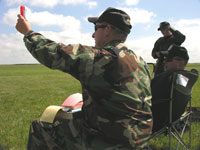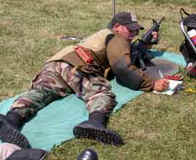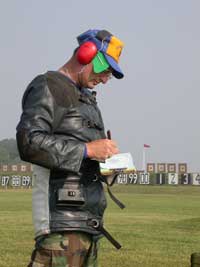As a competitor and observer of many rifle matches, the one thing I notice shooters forgetting to do on a regular basis is updating their data book. A data book is a valuable tool for the shooter. It allows you to have a daily journal of your shooting performance. This journal can and should be referenced every time a shooter steps on the range. When reviewing your data book you will be able to compare the conditions you face today with your previous performances in similar conditions.
When you look at a data book, you will notice that there are many different sections. Each section is important to fill out, however some are more important than others. For example, the date, target number and relay number are important to you as a reminder, but not important as a performance measure. The real meat and potatoes of the data book lies in the environmental, no wind and corrected zero, called and plotted shots, and performance notes section.
The environmental sections include places to record wind direction and speed, temperature and light direction and condition; some may have a place to record humidity.
 |
| USAMU team member uses a wind meter to record the wind during the National Matches at Camp Perry. |
WIND: Wind direction and speed play important roles in the placement of shot groups. Therefore it is important to annotate the conditions that you shoot in. Then, if you encounter the same conditions the following day or a couple of days later, you can see how that condition affected your performance.
Our team records the wind speed in MPH. You can estimate this by feel or use a wind meter. Generally a close estimation will be precise enough. We record the direction of the wind with a simple arrow. The direction of the wind is observed by the range flags or by simple feel. You could also record the value of the wind, that is as full value, half value, no value, or something in between.
LIGHT: Changes in light conditions and direction can affect your ability to place your shot group in the center of the target. The direction that a range faces and where the sun is in relation to you can alter your perception of both the sights and the target. By keeping an accurate record in your data book you will see how light affects your performance.
Light conditions are kept in generalized terms such as: Cloudy, bright, partly cloudy, dark, hazy, clear, and whatever else you can use to describe the day that you are encountering. You may also note the light conditions of the target. This may help you in deciding which hold you are going to use for that day.
Show the direction with an arrow. Simply orient the data book down range and stand your pen up, similar to a sundial, and mark where the shadow lies. You may also wish to keep track of where the sun is. If it is early morning or close to evening, the sun may also affect you.
 |
| USAMU team member records data
in his databook
during the match. |
TEMPERATURE: Temperature and humidity affect the elevation setting required to hit the center of the target. Use this section to record the temperature and humidity when you are shooting to see how this affects you. You can record it in general terms such as: Hot, cool, mild, warm, muggy, humid, dry, etc. You can also be more precise by using a thermometer. You can also get this info from the newspaper or internet reports.
The performance section of your data book should include sections for: No wind and corrected zeroes, called and plotted shots, sight picture, and performance notes.
ZEROES: For obvious reasons, you must keep track of your zeros. However, as you travel to other ranges you may have shifts in your zeroes. Most of these shifts occur because of the aforementioned environmental changes, but they can also occur because of the layout of the range. For example, if the targets are higher or lower than the firing line of your home range, you zero for that range may be different.
You should track your no wind zero. A no wind zero is a sight setting that allows you to hit the center of your target in a no wind condition. It is the zero that you are going to put on your gun to start with. A no wind zero includes elevation and windage zeroes.
When you are done with shooting, you should immediately count off your zeroes and annotate any changes that you had. Do not be afraid to change your zeroes during your sighting period or between strings. Make sure you record your new zeroes and start with those the next day.
 |
| A highpower competitor plots his shots during the President's Rifle Match. |
SHOTS: Keeping track of your plotted shots in comparison with your called shots will allow you to see trends or patterns in your groups. This will allow you to make the appropriate corrections to keep your groups centered.
By observing where your front sight post is the moment that the shot breaks, you will be able to call your shot. A called shot is where you think that shot will be on the target. After the target is marked you will be able to tell if you are "on call". If you are on call then all is well. However, if you are not on call then some sort of sight adjustment must be made. Keeping track of called shots may help indicate necessary adjustments. A mistake that I see shooters’ making is recording the score or value of their shots in the spaces provided.
Plotting your shots is simply marking them in your data book where the shots come up when the target is marked. During your performance you may see that you are "building" on one side of the target. This should tell you that some sight adjustment is needed. If you notice at the end of your performance that you were on one side of the target make sure that you move your zeroes to the center After taking the wind into account, you will be able to make this your no wind zero.
Your data book should also have a place to record the wind that you either have on the gun or the wind that you used for the string of firing. Be sure to record the wind that you have on the gun as you go so you do not get "lost:. You should always know how much wind is on your gun.
PERFORMANCE NOTES: Our data book has a section dedicated to the lessons of the day. Included in this section should be anything that affected your shooting, positive or negative. This section is not for excuses, but instead is for recording lessons that can help you the next time. Generally try to describe the positive things you accomplished that day. If you figured something out, use this section as a reminder of what you learned and how to apply it again.
You can also use this section to record your sight picture. It is important to remember what you used and how it affected your zero. From day to day a line of white, or any other hold, may look a little different. If you keep track of what you were seeing, then you will be able to use that hold on similar days.
Your data book is a valuable tool that is often overlooked. If you do not have a data book, then invest in one. You can even make your own. By reviewing your performances and utilizing the history that the data book provides, your performances should improve.
|
